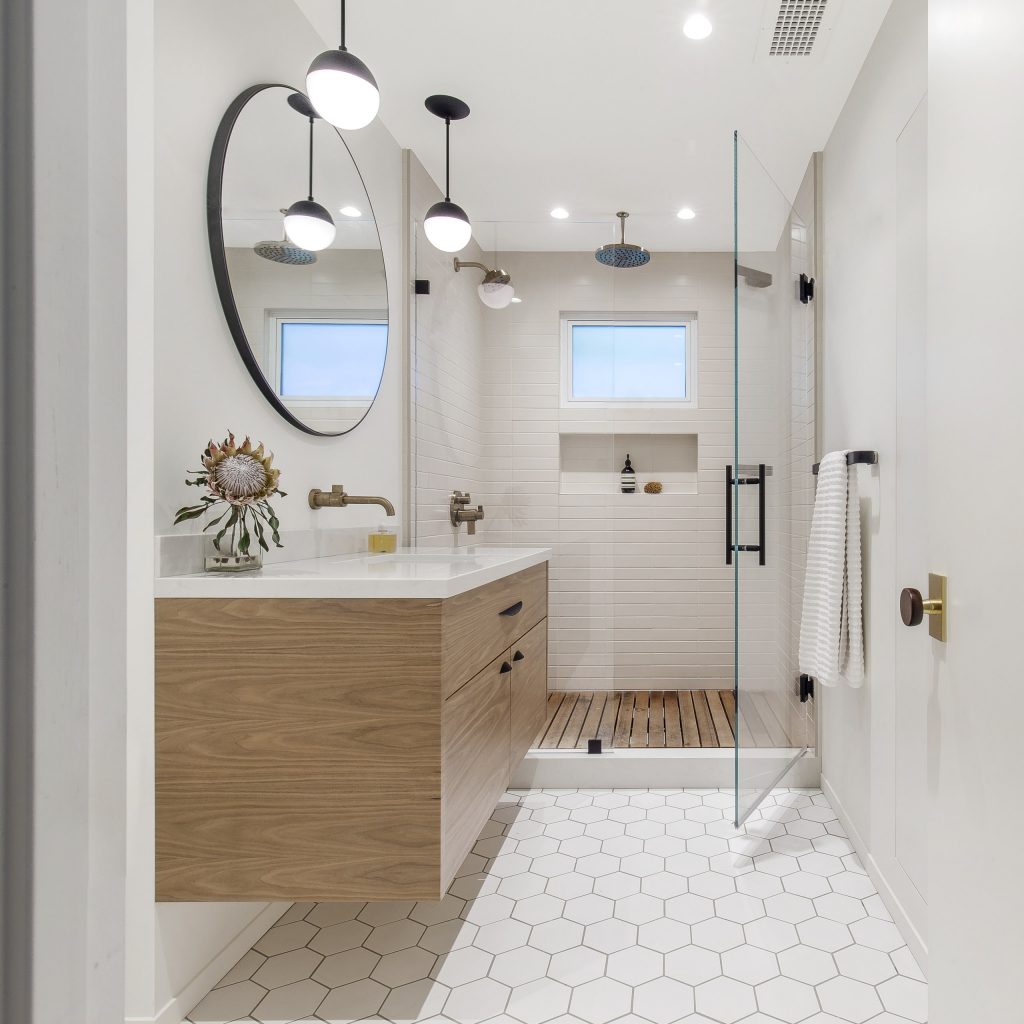A 3/4 bathroom offers the perfect balance of functionality and space-saving design, making it an ideal choice for guest suites, smaller homes, or adding an extra bathroom. Unlike a half-bath, a 3/4 bathroom includes a shower, enhancing convenience and privacy without the footprint of a full bath. This guide will walk you through everything you need to know about designing and planning a stylish and efficient 3/4 bathroom, from layout and fixture choices to cost considerations and maximizing your space.
Understanding the 3/4 Bathroom
So, what exactly is a 3/4 bathroom? Simply put, it contains a sink, a toilet, and a shower—everything you need except a bathtub. This makes them incredibly versatile for various situations. Let’s clarify how it differs from other bathroom types:
- Full Bath: The full bath is the gold standard, boasting a sink, toilet, shower, and a bathtub. It offers the most flexibility but requires the most space.
- Half-Bath (Powder Room): The minimalist option. Typically includes just a sink and toilet, perfect for guests but lacking showering facilities. Some half-baths may also include a shower, but this is less common.
- 3/4 Bath: Our focus. A practical compromise that provides essential washing facilities – sink, toilet, and shower – in a compact design.
Choosing a 3/4 bath offers several benefits beyond space-saving, including lower construction/renovation costs compared to a full bathroom and a potential increase in home value due to added functionality.
Planning Your 3/4 Bathroom: Size and Layout
Designing a 3/4 bathroom requires strategic space planning. While the average size is around 6ft x 6ft (36 sq ft), aiming for a slightly larger area, around 48 sq ft (e.g., 6ft x 8ft), is more likely to offer comfortable maneuverability. Homedit suggests even larger dimensions (7.8ft x 5.6ft) can enhance comfort.
Careful layout planning is essential. Consider these factors:
- Fixture Placement: One popular approach, as per Homedit, involves placing the sink behind the door to maximize open space. Experiment with different configurations to find what suits your specific dimensions.
- Door Swing: Ensure the door doesn’t interfere with fixtures or movement within the bathroom. Sliding doors can be a space-saving alternative.
- Traffic Flow: How will people move around in the bathroom? Design the layout to ensure a smooth and logical flow.
Designing with Style: Fixtures and Finishes
Don’t let the smaller size limit your style! A 3/4 bathroom can be just as chic as a larger space.
- Shower Selection: A walk-in shower is typically the most space-efficient choice. Compact shower/tub combos offer bathing options if desired.
- Vanity Options: A smaller vanity with a vessel sink can save space while adding a touch of elegance. Consider vanities with built-in storage to keep clutter at bay.
- Storage Solutions: Maximize vertical space with wall-mounted shelves, recessed cabinets, or a medicine cabinet above the sink.
- Lighting: Bright, well-placed lighting can make the space feel larger and more inviting.
- Decorative Touches: Add personality with plants, artwork, or colorful towels to create a spa-like atmosphere.
Cost Considerations and Remodeling Tips
Understanding the costs associated with a 3/4 bathroom project is crucial. Factor in demolition, plumbing, fixtures, flooring, tiling, lighting, and labor. Obtaining multiple quotes from licensed contractors is highly recommended. For those handy with DIY, tackling some aspects of the project can potentially save money. Resources like Bathfitter, Bath & Shower Remodeling, Jacuzzi, and NewBathPros might also offer helpful insights into broader cost considerations, though specific information for 3/4 bathrooms may require further research.
Accessibility and Future-Proofing
Incorporating accessibility features, such as grab bars, a curbless shower, and wider doorways, is highly beneficial. These elements enhance usability for people of all abilities and can increase your home’s value. Keep an eye on current research and evolving trends in bathroom design to stay ahead of the curve and explore sustainable materials like bamboo or recycled glass tiles. For a truly unique space, explore stunning 3 season room ideas to extend your living area into the outdoors.
DIY or Delegate?
Deciding whether to DIY or hire a professional is a key consideration.
| Feature | DIY | Professional |
|---|---|---|
| Cost | Lower initial cost, potential for unexpected expenses | Higher initial cost, more predictable budget |
| Time | Takes significantly longer, dependent on your skill level | Faster completion, depends on contractor availability |
| Expertise | Requires specific skills, learning curve involved | Guaranteed expertise, less risk of mistakes |
| Risk of Mistakes | Higher risk of errors, potentially costly to fix | Lower risk, professional accountability |
| Quality of Work | Variable, depends on your skill | Generally higher quality, professional standards |
Ultimately, the choice depends on your budget, skills, and comfort level. Consider blending DIY with professional assistance where appropriate. Perhaps channel some retro vibes with inspiring 1960s kitchen design ideas.
The .75 Bathroom: Another Name, Same Concept
You may also encounter the term “.75 bathroom” or “¾ bathroom”—it’s simply another designation for the 3/4 bath. This term is frequently used in real estate listings.
Small 3/4 Bathroom Dimensions
A small 3/4 bathroom can range from a compact 24-32 square feet to a more comfortable 48 square feet. Prioritizing clever layout strategies, compact fixture selections, and smart design elements is crucial for maximizing the functionality and style of these smaller spaces.
By carefully considering these aspects, you can create a 3/4 bathroom that perfectly balances functionality, style, and space efficiency. Remember, it’s all about making the most of what you have to create a bathroom you’ll truly love.
- How to Get Rid of Mushrooms in Your Lawn: A Complete Guide - April 24, 2025
- How to Get Rid of Ground Hornets: A Safe and Effective Guide to Eliminating Nests - April 24, 2025
- How to Get Rid of German Roaches Fast: DIY Methods for Quick Control - April 24, 2025










